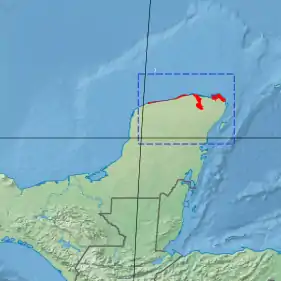| Ría Lagartos mangroves | |
|---|---|
.jpg.webp) | |
 Ecoregion territory (in red) | |
| Ecology | |
| Realm | Neotropical |
| Biome | Mangroves |
| Borders | |
| Geography | |
| Area | 3,626 km2 (1,400 sq mi) |
| Country | Mexico |
| Coordinates | 21°36′N 88°05′W / 21.6°N 88.08°W |
The Ría Lagartos mangroves ecoregion (WWF ID: NT1430) covers mangrove habitats of along the northern coast of the Yucatan Peninsula, including the Ria Lagartos Lagoon ('Ria' meaning lagoon). A prominent section of the ecoregion is covered by the Ría Lagartos Biosphere Reserve. The site is an important area for migratory birds, fish, and sea turtles.[1][2][3]
Location and description
The ecoregion stretches across 300 km of the northeastern coast of the Yucatan Peninsul, from the coastal town of Chelem in the west to the coastal lagoons north of Cancun. The region also reaches inland for 50 km on flat land south of Playa las Coloradas. The distinctive character of the mangroves is partly due to the karst (limestone) topography and freshwater source.[4] The ecoregion is surrounded on the land side by the Yucatan dry forests ecoregion.
Climate
The climate of the ecoregion is Tropical savanna climate - dry winter (Köppen climate classification (Aw)). This climate is characterized by relatively even temperatures throughout the year, and a pronounced dry season. The driest month has less than 60 mm of precipitation, and is drier than the average month.[5][6]
Flora and fauna
Characteristic tree species of the ecoregion are the red mangrove (Rhizophora mangle) and the black mangrove (Avicennia germinans). Mangroves are found in two general types: pygmy mangroves (plants under 2 meters in height), and fringe mangroves (where trees may reach 20 meters.)[1]
Over 280 species of aquatic birds have been recorded in the region, include the cormorant (Phalacrocorax), wood stork (Mycteria americana), boat-billed heron (Cochlearius cochlearia), and the white egret (Egretta alba). 73 fish species are supported by the mangroves of the region.[3]
Protected areas
Officially protected areas of the ecoregion include:
- Ría Lagartos Biosphere Reserve
- Reserva Estatal de Dzilam de Bravo
References
- 1 2 "Ría Lagartos mangroves". World Wildlife Federation. Retrieved November 20, 2020.
- ↑ "Map of Ecoregions 2017". Resolve, using WWF data. Retrieved November 20, 2020.
- 1 2 "Ría Lagartos mangroves". The Encyclopedia of Earth. Retrieved November 20, 2020.
- ↑ "Humedal de Importancia Especialmente para la Conservación de Aves Acuáticas Reserva Ría Lagartos". RAMSAR Sites Information Service. Retrieved November 20, 2020.
- ↑ Kottek, M., J. Grieser, C. Beck, B. Rudolf, and F. Rubel, 2006. "World Map of Koppen-Geiger Climate Classification Updated" (PDF). Gebrüder Borntraeger 2006. Retrieved September 14, 2019.
{{cite web}}: CS1 maint: multiple names: authors list (link) CS1 maint: numeric names: authors list (link) - ↑ "Dataset - Koppen climate classifications". World Bank. Retrieved September 14, 2019.